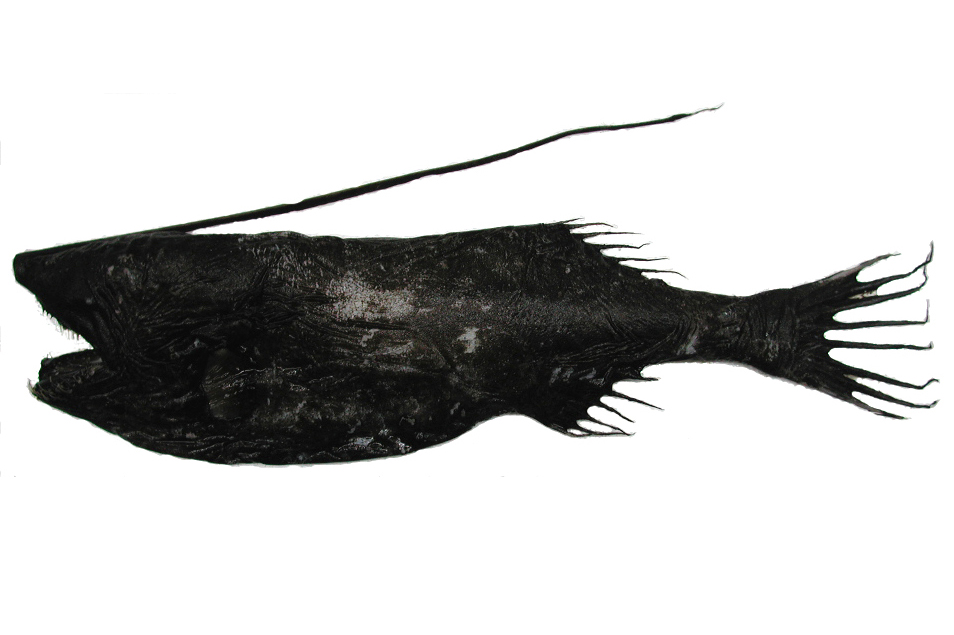Cosmopolitan Whipnose, Gigantactis vanhoeffeni Brauer 1902

A female Cosmopolitan Whipnose, Gigantactis vanhoeffeni, from Taiwan, ASIZP 61799 . Source: Ho, Hsuan-Ching / FishBase. License: All rights reserved
Summary:
A large dark brown to black whipnose with a relatively short illicium (length <120% SL), relatively short caudal-fin rays (<45% SL), and the esca with a black spiny distal elongation. Males are unknown.
Cite this page as:
Bray, D.J. 2022, Gigantactis vanhoeffeni in Fishes of Australia, accessed 27 Jun 2025, https://fishesofaustralia.net.au/home/species/2714
Cosmopolitan Whipnose, Gigantactis vanhoeffeni Brauer 1902
More Info
|
Distribution |
Recorded from off northeastern Tasmania, depth 825-1100 m. Elsewhere the species is circumglobal in tropical and temperate waters. |
|
Features |
Dorsal fin 5-7; Anal fin 5-7; Pectoral fin 17-18. Illicium relatively short, length less than 120% SL (71-112% SL in specimens greater than 12.5 cm SL), with no basal filaments; esca covered in minute spines, bearing distally-flattened papillae, and with an elongate, darkly pigmented distal prolongation attached to escal bulb; short, black filaments concentrated around tip of the prolongation; escal bulb with 2-3 unpigmented filaments; close-set pair of small appendages on posterior margin of illicium some distance below bulb. Dentary teeth in three longitudinal series, relatively long (longest 2.6-5.0% SL). Length of caudal-fin rays less than 45% SL. |
|
Feeding |
Stomach contents include bony fishes and squid. The large teeth positioned outside the jaws enable this species to seize large prey. |
|
Biology |
Female and male gigantactinids are extremely sexually dimorphic. The dwarf males attach to the much larger females for a small period of time using pincer-like denticles - they do not permanently attach to females. |
|
Similar Species |
Differs from other Gigantactis species in having a relatively short illicium with no basal filaments, and in the morphology of the escal bulb. |
|
Species Citation |
Gigantactis vanhoeffeni Brauer 1902, Zoologischer Anzeiger 25(668): 296. Type locality: East of Zanzibar, Tanzania, 0 to 2500 m. [5°42'S, 43°36'E]. |
|
Author |
Bray, D.J. 2022 |
|
Resources |
Cosmopolitan Whipnose, Gigantactis vanhoeffeni Brauer 1902
References
Anderson, M.E. & Leslie, R.W. 2001. Review of the deep-sea anglerfishes (Lophiiformes: Ceratioidei) of southern Africa. Ichthyological Bulletin of the J.L.B. Smith Institute 70: 1-32.
Bertelsen, E., Pietsch, T.W. & Lavenberg, R.J. 1981. Ceratioid anglerfishes of the family Gigantactinidae: morphology, systematics, and distribution. Natural History Museum of Los Angeles County Contributions in Science 332(6): 1–74 See ref at BHL
Brauer, A. 1902. Diagnosen von neuen Tiefseefischen, welche von der Valdivia-Expedition gesammelt sind. Zoologischer Anzeiger 25(668): 277-298 See ref at BHL
Knudsen, S. 2015. Gigantactis vanhoeffeni. The IUCN Red List of Threatened Species 2015: e.T60470687A60788211. http://dx.doi.org/10.2305/IUCN.UK.2015-4.RLTS.T60470687A60788211.en. Downloaded on 11 August 2017.
Pietsch, T.W. 1999. Families Caulophrynidae, Neoceratiidae, Melanocetidae, Himantolophidae, Diceratiidae, Oneirodidae, Thaumatichthyidae, Centrophrynidae, Ceratiidae, Gigantactinidae, Linophrynidae. pp. 2026-2037 in Carpenter, K.E. & Niem, V.H. (eds). The Living Marine Resources of the Western Central Pacific. FAO Species Identification Guide for Fisheries Purposes. Rome : FAO Vol. 3 pp. 1397-2068.
Pietsch, T.W. 2005. Dimorphism, parasitism, and sex revisited: modes of reproduction among deep-sea ceratioid anglerfishes (Teleostei: Lophiiformes). Ichthyological Research 52(3): 207-236. https://doi.org/10.1007/s10228-005-0286-2
Pietsch, T.W. 2009. Oceanic Anglerfishes. Extraordinary Diversity in the Deep Sea. Berkeley and Los Angeles : University of California Press pp. i-xii + 1-557.
Stewart, A.L. & Pietsch, T.W. 2015. 122 Family Gigantactinidae. pp. 932-936 in Roberts, C.D., Stewart, A.L. & Struthers, C.D. The Fishes of New Zealand. Wellington : Te Papa Press Vol. 3 pp. 577-1152.





